
Yireo Extensions
Professional extensions for Magento 2 and Shopware 6
We build solid, reliable Magento 2 & Shopware 6 extensions, so that you can build shops efficiently: Our extensions range from handy little tools to more advanced code that saves you time.
What we build is reliable and of high quality
We build extensions because we want to raise the standard
Loki Components
Alpine-driven blocks with AJAX-calls to their backend
Loki Checkout
A fast, extendable new checkout for Magento 2
Loki Admin Components
Faster and easier grids and forms in the Magento Admin
GoogleTagManager
Add GTM to Magento including GA4 support
DeleteAnyOrder
Delete orders safely and reliably from your Magento 2 database
EmailTester
Preview any transactional email in your Magento 2 backend
ThemeCommands
Handy CLI commands for managing Magento themes
Magento EU Tax Rates
Tax rates in CSV managed by the community
CspWhiteListInlineJs
Quick fix for CSP whitelisting any inline JS
Disable CSP
If you do not like it, disable it
Admin Auto Login
Automatically login to your Shopware 6 Administration
WebP2
Serve smaller images to modern browsers like Chrome
Whoops
Integrate Whoops in Magento and prettify your exception pages
Easier Extension Attributes
Making Magento extension attributes easier to implement
ExtensionChecker
Quickly validate Magento 2 extensions using various coding practices
Composer Replace Tool
Remove composer packages from the Magento core
TaxRatesManager
Update & create tax rates automatically, when you are sleeping
CategoryExtended
Include more than just Magento categories in the main menu
List Entities
CLI for listing Shopware 6 entities
SalesBlock2
Stop wasting time on orders that you need to reverse anyway
LinkPreload
Send initial CSS and JS faster to browsers using HTTP/2 preload
CheckoutTester
Preview the checkout success page anytime you want to customize it
Integration Testing Helper
Helper for your Shopware 6 integration tests
GraphQlRateLimiting
Prevent GraphQL query and mutation attacks
Theme Override Checker
Manage your Magento theme overrides better
GraphQl QueryLimiter
Easily customize settings for the GraphQL Query Limiter
List Decorators
CLI for listing service decorators in Shopware 6
Endpoints for GraphQl
Additional GraphQL endpoints for developing headless Magento shops
Sync GraphQl Session
Make sure the GraphQL token is in sync with a regular session
BackendReindexer
Reindex Magento indices from within your Magento 2 Admin Panel
AutoFlushCache
Automatically wipe the Magento cache when changing the configuration
Disable ServiceWorker
Turn off the ServiceWorker for the Magento Admin Panel
File Link Mapper
Map folders between Docker host and container in Shopware 6
Twig Env
Expose ENV in your Shopware 6 Twig templates
Additional config commands
Handy additions for dealing with the Shopware 6 system:config commands
Additional user commands
Handy additions for dealing with the Shopware 6 users from the CLI
Additional customer commands
Handy additions for dealing with the Shopware 6 customer from the CLI
SystemInfo command
CLI for gathering info on your Shopware 6 environment

Jisse gave a very interesting, practical and well-constructed story about the Magento 2 junglePeter Keijsers (Experius)

